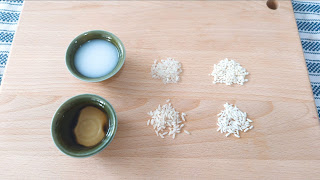Sweet rice wine is a young, low-alcohol dessert wine that is remarkably sweet and fruity in flavor, for something that's derived purely from rice, with no added sugar or juice. Almost anyone who tried sweet rice wine for the first time will tell you they would not have imagined this is made from just rice. The flavor is akin to lychee juice, or lightly fermented yogurt drinks (think Calpico or Yakult). This flavor resemblance was recorded as early as 800AD, by the Tang Dynasty poet Bai Juyi in his Introduction to Lychee. Before the age of mass produced table sugar or modern transportation for fresh fruits, being able to get something this sweet and flavorful from the humble starchy grains was something to treasure.The mechanism is simple - cooked rice is introduced to rice wine yeast, which contains strands of oryzae
fungi, which secretes the enzyme amylase that breaks down the starchy polysaccharide into shorter disaccharide (maltose) or monosaccharide (glucose) - which actually tastes sweet, and can be digested by the yeast to turn into alcohol. There are two main variant of rice fugus, Aspergillus oryzae, which is commonly found in the japanese koji, and Rhizopus oryzae, which is commonly found in chinese qu. Though pronounced differently, koji and qu share the same written character, 麹, as the two share a common root. To oversimplify the difference a little, Aspergillus oryzae secretes more α-amylase (which produces maltose) in addition to γ-amylase (which produce glucose), and is often used at a higher temperature (~60C), while Rhizopus oryzae relies more on glucoamylase, and is often used at a lower temperature (~30C).
The amylolytic process is faster with α-amylase at the higher temperature (6~8hrs vs 24~36hrs), but maintaining this higher warm-but-not-too-hot temperature requires precision cookers or more attendance. The lower maintenance temperature is easier to get hands-off, especially in the middle of summer. I stick mine in the garage and treat it like no-knead dough - sure it takes longer, but you don't need to do anything about it. The active time for this recipe is very, very short.
The traditional method calls for soaking short grain glutinous rice (also known as sweet rice or sticky rice) over night, steaming until thoroughly cooked, spreading the rice out to let it cool naturally, and adding water with rice wine yeast. It's not super complicated as is, but overnight soaking takes more planing ahead, and steaming properly is actually not so fool-proof. Depending on the steamer used, it is easy to get uneven heating, with mushy, overcooked rice in some places, and hard, undercooked rice in other places. I strongly recommend beginners to just use a rice cooker. The underlying reason for steaming is simply to cook through the rice kennels for starch gelatinization, which enables amylase to break down the polysaccharide into smaller sugar molecules (maltose or glucose). Obviously tradition can't call for electronic smart cookers. No reason for modern people to forgo the easier technology.
About the rice selection - tradition favors rice types higher in amylopectin (branched starch) than amylose (single-chain starch), because its branched structure readily releases more glucose, allowing for more efficient fermentation, and higher potential alcohol content when aged. It also forms a more stable gel that doesn't retrograde as easily. So where selection is possible, try to pick a rice that's high in amylopectin. 2. Containers should be thoroughly cleaned and dried before using. While the sanitation standard isn't as strict as more aged wine, it's still a fermentation vessel. At least put it through a high heat cycle in the dishwasher and let it heat-dry. Preferably boil, steam, or oven bake the containers to sterilize. If oven baking, I recommend preheating with the containers in oven, to ensure more even heating through out the container.
2. Containers should be thoroughly cleaned and dried before using. While the sanitation standard isn't as strict as more aged wine, it's still a fermentation vessel. At least put it through a high heat cycle in the dishwasher and let it heat-dry. Preferably boil, steam, or oven bake the containers to sterilize. If oven baking, I recommend preheating with the containers in oven, to ensure more even heating through out the container. 
- Cook rice to package instruction, or rice cooker/instant pot instruction.
- Rinse with cold water to break up the rinse and cool to room temperature. Drain thoroughly.
- Dissolve the yeast in water, and mix into the rice. (you can also mix in the dry yeast directly if the rice is very wet)
- Pack rice into sanitized container. Carve out a hole in the middle to observe alcohol secretion level.
- Loosely wrap up the container and leave it somewhere warm and away from light (e.g. inside a cardboard box in the garage). Ideal fermentation temperature is ~30C; 25~35C are all acceptable.
- Check the rice every ~24hrs. Once the alcohol shows through the hole, or pools around the bottom of class jar and rice is floating, move to the fridge. About 36~48 hrs. You can always refrigerate after a day and let cold fermentation continue in the fridge. Avoid leaving the rice out for more than 3 days, to prevent over-fermentation or spoilage.
 Drain over a nut milk bag if drinking straight. Sweet rice can also be eaten as is, or cooked with mochi for a dessert soup. It can also be steamed with milk to form a soft custard (2 part milk: 1 part drained rice wine).
Drain over a nut milk bag if drinking straight. Sweet rice can also be eaten as is, or cooked with mochi for a dessert soup. It can also be steamed with milk to form a soft custard (2 part milk: 1 part drained rice wine).











Comments
Post a Comment